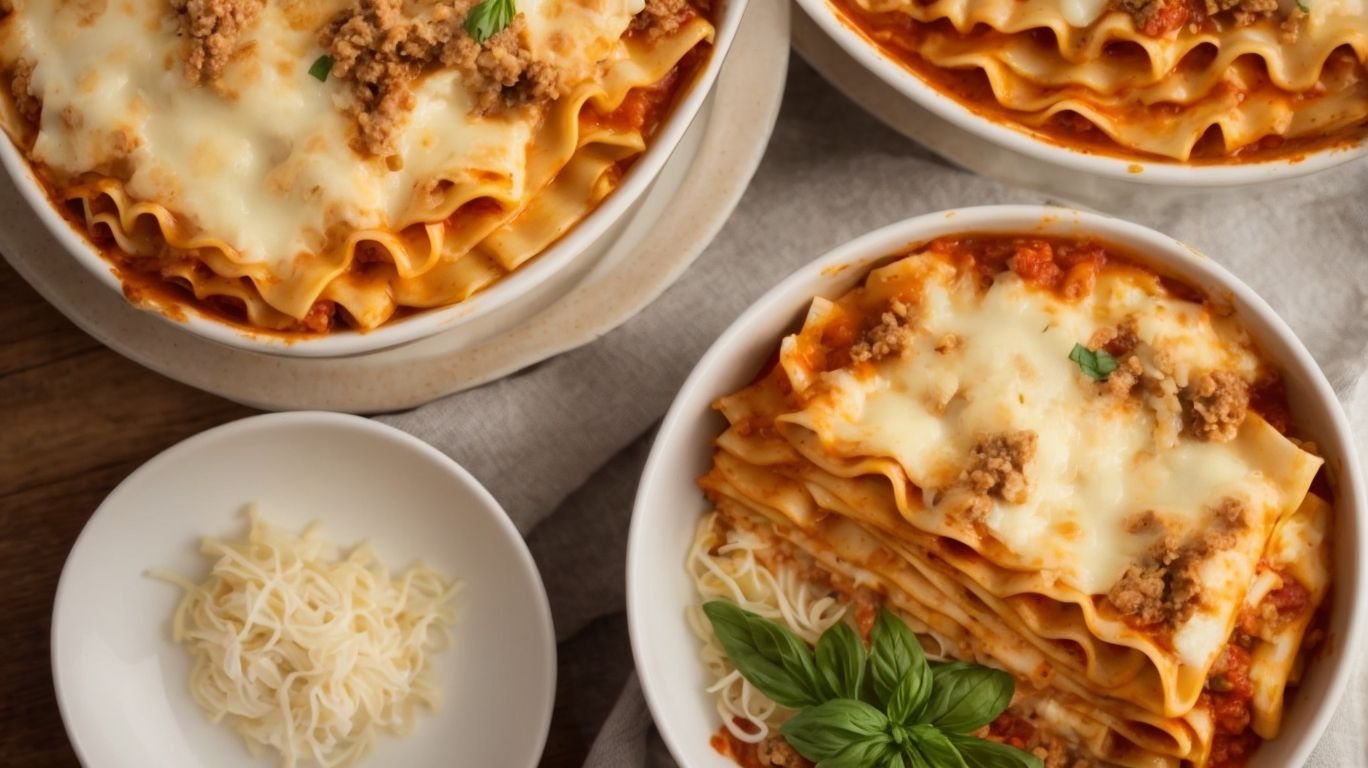How to Cook Noodles for Lasagna?
Are you a fan of the classic Italian dish, lasagna, but unsure about the different types of noodles to use?
We will explore the various types of lasagna noodles available, from traditional to no-boil to fresh. We will discuss the best methods for preparing these noodles for cooking, including boiling, soaking, and using no-boil options.
Get expert tips on cooking the perfect lasagna noodles and how to layer them in a lasagna dish for a delicious meal. Let’s dive in and discover the secrets to making the perfect lasagna noodles!
Key Takeaways:
What Are the Different Types of Lasagna Noodles?
Lasagna noodles come in various types, including traditional, no-boil, and fresh options, each offering a unique texture and taste.
Traditional lasagna noodles are the classic choice for making the quintessential Italian dish. These noodles require boiling before assembling the lasagna, thus allowing them to absorb the flavors of the sauce and other ingredients.
On the other hand, no-boil lasagna noodles are a convenient option that can be used directly in the dish without pre-cooking. They are especially handy for saving time in busy kitchens.
Fresh pasta sheets, a premium alternative, bring a delicate and luxurious texture to the lasagna, making them ideal for special occasions or gourmet recipes.
Traditional Lasagna Noodles
Traditional lasagna noodles are typically made from homemade pasta dough, rolled thin, and cut into rectangular shapes for layering in the dish.
To create these delectable noodles from scratch, you will need a simple combination of ingredients such as all-purpose flour, eggs, and a pinch of salt. Begin by forming a well with the flour, cracking the eggs into it, and incorporating the mixture until a smooth and elastic dough forms. This process allows the gluten to develop, giving the noodles their desirable texture.
Once the pasta dough is ready, divide it into manageable portions to roll out with a pasta machine or rolling pin. Gradually work the dough to achieve a consistent thickness; remember, lasagna needs slightly thicker noodles than other pasta shapes to maintain structure during baking.
No-boil Lasagna Noodles
No-boil lasagna noodles are a convenient option that can be layered directly into the dish without the need for pre-cooking, saving time and effort in the kitchen.
-
These noodles are especially beneficial for busy individuals or beginner cooks who want to create a delicious lasagna without the fuss of boiling noodles.
-
The time-saving feature of no-boil lasagna noodles makes them perfect for weeknight dinners or when you’re short on time but craving a hearty, homemade meal.
-
With traditional lasagna noodles, the preparation process can be quite lengthy, involving boiling the noodles separately, draining them, and then assembling the dish. With no-boil lasagna noodles, you can skip these steps altogether.
Fresh Lasagna Noodles
Fresh lasagna noodles offer a delicate texture and rich flavor, providing a gourmet touch to homemade lasagna dishes.
Using fresh pasta not only enhances the overall taste of your lasagna but also ensures a more authentic Italian dining experience. Fresh lasagna sheets absorb sauces better, resulting in a more delicious and well-balanced dish.
To store fresh lasagna noodles properly, wrap them tightly in plastic wrap and keep them refrigerated. When handling fresh pasta, be gentle to avoid tearing, and always cook it al dente for the perfect texture.
How to Prepare Lasagna Noodles for Cooking?
Preparing lasagna noodles for cooking involves various methods such as boiling, soaking, or using the convenient no-boil option, depending on the type of noodles chosen.
When boiling lasagna noodles, ensure you use a large pot with an ample amount of salted water to prevent sticking. As the water reaches a rolling boil, gently add the noodles, stirring occasionally to prevent clumping. Different noodle types may have varying cooking times, so consult the package instructions for guidance.
If you opt for soaking, place the noodles in a large container filled with room temperature water. Let them soak for at least 30 minutes, occasionally separating them to ensure even hydration.
Consider using fresh pasta noodles for a shorter cooking process, or if using dried noodles, a slightly longer boiling or soaking time may be required.
Boiling Lasagna Noodles
Boiling lasagna noodles involves bringing a pot of salted water to a rolling boil and cooking the noodles according to the package instructions until they reach the desired al dente texture.
When boiling lasagna noodles, it’s essential to add a generous amount of salt to the water; this not only seasons the noodles but also helps enhance their flavor as they absorb the salt during cooking. Never overcrowd the pot with too many noodles as this can result in uneven cooking. Remember to stir the noodles occasionally to prevent them from sticking together and ensure even cooking throughout. Following the cooking instructions on the package is crucial for achieving the perfect texture, as timings may vary based on the brand. Observing the noodles closely towards the end of the cooking process will help you achieve that ideal balance between tender and firm – the signature al dente consistency that makes lasagna truly delicious.
Soaking Lasagna Noodles
Soaking lasagna noodles in warm water allows them to hydrate and soften before assembling the dish, ensuring even cooking and a cohesive texture in the final lasagna.
This process typically involves placing the lasagna noodles in a bowl of warm water for about 30 minutes, allowing them to absorb moisture and become pliable. The ideal temperature for the water is around 100-110°F, not too hot to cook the noodles but warm enough to quicken the hydration process.
During this soaking period, the noodles rest and become more flexible, making them easier to handle when layering them in the dish. By hydrating the lasagna noodles beforehand, you prevent them from absorbing too much moisture from the sauce during baking, resulting in a perfectly cooked and textured lasagna.
Using No-boil Lasagna Noodles
No-boil lasagna noodles can be used directly in the lasagna dish without any pre-cooking, simplifying the preparation process and reducing overall cooking time.
This convenience makes them a go-to option for busy weeknights or whenever you want to whip up a delicious lasagna without the extra steps.
When using no-boil noodles, it’s essential to ensure that there is enough liquid in your sauce or filling to allow the noodles to cook properly. You may want to increase the amount of sauce or add a bit of water to the recipe to compensate for the noodles absorbing moisture during baking.
What Are the Tips for Cooking Perfect Lasagna Noodles?

Credits: Poormet.Com – Jeffrey Flores
Cooking perfect lasagna noodles requires attention to details such as using a large pot, salting the water, and stirring the noodles frequently to prevent sticking and ensure even cooking.
When selecting a pot to cook your lasagna noodles, opt for a large pot that provides ample space for the noodles to move freely without clumping together. The ideal pot size ensures that the noodles have enough room to cook evenly.
- Adding the right amount of salt is essential to enhance the flavor of the noodles. A good rule of thumb is to use approximately 1 tablespoon of salt for every 4 quarts of water.
- Remember to stir the noodles occasionally to prevent them from sticking to each other or the pot. Stirring also helps distribute the heat evenly for consistent cooking.
- To test if the noodles are done, take a piece out and taste it. It should be tender, but still slightly firm (al dente) as it will continue to cook in the oven with the sauce.
Use a Large Pot
Using a large pot when cooking lasagna noodles allows the noodles to move freely in the boiling water, preventing clumping and ensuring uniform cooking.
When you have ample water circulation in a large pot, the noodles have enough space to cook evenly without sticking together. This is crucial for lasagna noodles, as they tend to be long and wide, requiring sufficient room to soften uniformly. The large pot helps maintain the boiling temperature more effectively, resulting in quicker cooking times and a better texture for your lasagna dish. So, next time you’re preparing lasagna, reach for that spacious pot to achieve perfectly cooked noodles every time.
Salt the Water
Adding salt to the water when boiling lasagna noodles enhances the flavor and helps season the noodles throughout, contributing to a more delicious final dish.
When the noodles cook in salted water, they absorb some of the salt, which leads to a subtle yet crucial enhancement in taste. The salt also helps to strengthen the structure of the noodles, preventing them from becoming mushy or bland.
For the ideal amount of salt in the boiling water, a general rule of thumb is to use about 1-2 tablespoons of salt per gallon of water. This ratio ensures that the noodles get adequately seasoned without being overly salty.
Stir the Noodles
Stirring the lasagna noodles while boiling ensures even cooking and prevents the noodles from sticking together, leading to a uniformly cooked and delightful pasta texture.
For successful pasta cooking, it’s essential to stir the noodles frequently during the entire cooking process. Aim to stir the noodles every 2-3 minutes to ensure they don’t clump or stick together. This consistent stirring action not only helps distribute the heat evenly but also prevents the noodles from becoming overly soft or undercooked in certain spots.
Test for Doneness
Checking for doneness by tasting a noodle is crucial to ensure the perfect al dente texture in lasagna noodles, indicating they are fully cooked yet slightly firm.
When testing for doneness, look for a noodle that is tender on the outside but still has a slight bite to it in the center. This texture, known as al dente, is the hallmark of perfectly cooked pasta. If the noodle feels mushy or overly soft, it needs more time to cook. To adjust the cooking time, continue to check the noodles every few minutes until they reach the desired consistency. Remember, overcooked noodles can ruin the texture of your lasagna, so it’s important to monitor them closely.
Drain and Rinse the Noodles
Draining and rinsing cooked lasagna noodles in cold water stops the cooking process and prevents them from sticking together, ensuring they are ready for layering in the lasagna dish.
This crucial step not only cools down the noodles quickly, but it also helps remove excess starch, which can make the noodles gummy if left on. By rinsing, you are not only preparing the noodles for assembly but also ensuring they maintain their firm texture and shape, providing a delightful mouthfeel in every bite of the finished dish. Taking the time to drain and rinse the lasagna noodles is a simple yet impactful way to elevate the overall quality of your lasagna. This small extra effort can make a significant difference in the final taste and presentation of the dish.
How to Layer Lasagna Noodles in a Lasagna Dish?
Layering lasagna noodles in a dish involves alternating between noodles, sauce, filling, and cheese to create a delicious and visually appealing lasagna.
To begin, start by spreading a thin layer of sauce at the bottom of a baking dish to prevent the noodles from sticking. Place a layer of lasagna noodles over the sauce, ensuring they slightly overlap. Next, add a generous helping of your chosen filling, making sure to spread it evenly to ensure each bite is flavorful. Sprinkle a layer of cheese over the filling, providing that creamy and gooey element. Repeat these layers until the dish is almost full, finishing with a final layer of noodles topped with sauce and cheese for a golden, bubbly finish.
Start with Sauce
Beginning with a layer of sauce at the bottom of the dish sets the foundation for the lasagna, ensuring the noodles cook evenly and absorb the flavors of the sauce.
When you start by spreading a generous amount of sauce at the base, it not only prevents the noodles from sticking to the dish but also creates a moist environment that helps the pasta cook to perfection. The sauce acts as a barrier between the direct heat and the noodles, preventing them from becoming too dry during the baking process.
This initial layer of sauce not only plays a structural role in building a sturdy lasagna structure but also enhances the overall taste profile by infusing every bite with rich, savory flavors. As you add subsequent layers of noodles, cheese, and additional sauce, the foundation of that initial sauce layer continues to intermingle and meld with the other ingredients, creating a harmonious blend of flavors.
Add a Layer of Noodles
Placing a layer of cooked lasagna noodles on top of the sauce creates a barrier that retains moisture, ensuring the dish cooks evenly and the flavors meld together.
It’s crucial to handle the lasagna noodles with care to prevent them from tearing or sticking together. Be mindful of fully covering the sauce, ensuring an even distribution to guarantee each bite has a balance of flavors.
Layering the noodles also provides structure to the dish, allowing the filling to sit evenly and preventing a runny mess when serving. Take your time to arrange the noodles neatly, slightly overlapping each strand to create a solid foundation for the next layers.
Spread on the Filling
Evenly spreading the filling over the noodle layer ensures a balanced distribution of flavors and textures throughout the lasagna, creating a harmonious culinary experience.
When you distribute the filling evenly, you prevent any overwhelming bites filled with just one ingredient, ensuring that every mouthful is a delightful blend of all the components present.
By layering the filling with care, each lasagna noodle gets a chance to soak up the flavors, enhancing the overall taste profile of the dish.
Proper layering techniques not only impact the aesthetics of your lasagna but also play a crucial role in achieving the ideal texture balance, marrying the soft noodles with the savory filling into a perfect union of taste and enjoyment.
Repeat Layers
Layering lasagna noodles, sauce, filling, and cheese in a repetitive pattern ensures a well-structured and visually appealing lasagna dish with balanced flavors and textures.
- Start by spreading a thin layer of sauce at the bottom of your baking dish to prevent the noodles from sticking.
- Next, layer lasagna noodles evenly over the sauce, ensuring full coverage.
- Spread a generous amount of filling atop the noodles, such as a mix of ricotta, spinach, and mushrooms, to add depth of flavor.
- Drizzle more sauce over the filling before adding another layer of noodles.
- Repeat the layering process until you reach the top of the dish, finishing with a final layer of sauce and a generous sprinkling of cheese for that perfect golden-brown crust.
End with Sauce and Cheese
Finishing the lasagna layers with a final topping of sauce and cheese adds a flavorful and melty finish to the dish, creating an enticing golden crust during baking.
When you layer your lasagna, the final step of adding the sauce and cheese is crucial in enhancing the overall taste and texture of the dish. The sauce not only keeps the layers moist but also infuses each bite with rich flavor, while the cheese melts to perfection, contributing a gooey and indulgent element.
The golden crust that forms on the top layer of lasagna is a visual cue that promises a delightful crunchiness and adds an appealing contrast to the soft layers beneath. To achieve this, spread a generous amount of sauce and cheese, ensuring every corner is covered before placing it in the oven.
Conclusion: Tips for Making the Perfect Lasagna Noodles
Mastering the art of preparing lasagna noodles involves selecting the right type, cooking methods, and layering techniques to create a delicious and satisfying lasagna dish.
Regarding selecting the right type of noodles, opting for flat lasagna sheets is crucial for a traditional lasagna dish that holds its form while delivering a satisfying bite.
As for cooking methods, boiling the noodles until al dente is essential to prevent them from becoming mushy during the baking process, ensuring a perfectly cooked texture.
Layering finesse plays a vital role in the overall taste and presentation of your lasagna. Alternating layers of noodles, sauce, cheese, and other fillings creates a harmonious blend of flavors that meld together beautifully.
Frequently Asked Questions
How to Cook Noodles for Lasagna?
Cooking noodles for lasagna can be tricky since they tend to stick together and get mushy. Here are some tips to ensure perfectly cooked noodles every time.
What type of noodles should I use for lasagna?
Lasagna noodles are typically made from durum wheat and can be found in both traditional and no-boil versions. Traditional noodles need to be boiled before assembling the lasagna, while no-boil noodles can be used directly in the dish.
How do I prevent noodles from sticking together?
To prevent noodles from sticking together, add a teaspoon of oil to the boiling water before adding the noodles. Stir the noodles occasionally while cooking to ensure they don’t stick together.
Can I use regular pasta in place of lasagna noodles?
While you can use regular pasta in place of lasagna noodles, the texture and taste may be different. Lasagna noodles are specifically designed to hold up to the layers of sauce and cheese in the dish.
How long do I cook the noodles for lasagna?
The cooking time for lasagna noodles can vary depending on the brand and type. Generally, traditional noodles need to be boiled for 8-10 minutes, while no-boil noodles can be used directly in the dish without boiling.
Can I cook the noodles ahead of time?
Yes, you can cook the noodles ahead of time and store them in the refrigerator for up to 3 days. Just make sure to separate the noodles with a thin layer of oil to prevent them from sticking together.




